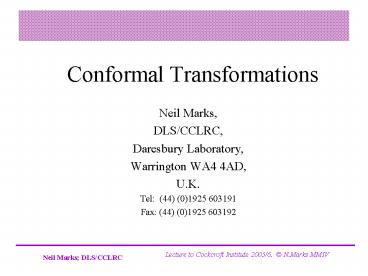Conformal Transformations - PowerPoint PPT Presentation
1 / 18
Title:
Conformal Transformations
Description:
The technique is based on transforming geometries using functions of the complex ... The analysis also uses the conformal transformation method: Neil Marks; DLS/CCLRC ... – PowerPoint PPT presentation
Number of Views:1648
Avg rating:3.0/5.0
Title: Conformal Transformations
1
Conformal Transformations
- Neil Marks,
- DLS/CCLRC,
- Daresbury Laboratory,
- Warrington WA4 4AD,
- U.K.
- Tel (44) (0)1925 603191
- Fax (44) (0)1925 603192
2
Use of transformations
- This is a mathematical technique developed to
give analytical expressions for potential
and flux density distributions for (simple)
geometries. - This was the standard technique for magnet design
before finite element analysis (f.e.a.) codes
were developed. - The technique is based on transforming
geometries using functions of the complex
variable. - We start with a model with unknown field and
potential distributions and transform that to a
geometry where distributions can be analytically
defined. The known distribution is then
transformed back to the initial model using the
inverse of the first transform, giving the
required result. - Each transformation often involves an
intermediate step.
3
The Transformations.
- We start by defining two complex planes, Z and W
All conformal transformations preserve the
angle of intersection between two curves
except at the origin and at poles of the
transforming function. As the most suitable
ideal pole to use for the known distribution
will be a pair of parallel poles extending
to plus and minus infinity, such a
function will be necessary.
4
The 'Schwarz - Christoffel' Transformation
- This is one type of a conformal transform it
transforms polygons (complete or open) in the
Z plane to a straight line on the real
axis in the W plane - The transformation is given by
- dZ/dW M ( W - a1)((a1/p ) -1) (W - a2)((a2/p )
- 1) ........ - where M is an arbitrary constant to be determined.
5
Second transformation.
- A second transformation is then used to
translate from a T plane, where the
geometry is an infinite dipole, back into
the W plane - The two transformations are then combined
to predict the distributions in the real
magnet.
6
Example a dipole end.
Transformation Z to W
dZ/dW M (W 1)1/2 ( W ) -1 Z M 2(W
1)1/2 ln (W 1)1/2 -1 - ln (W 1)1/2 1
N where N is another arbitrary constant N
0 just sets the origin in Z plane for W
-1, the above expression gives Z i M p i
g/2 so M g/2p for W gt 0, Z is real.
7
Transformation T to W
- The T plane, an infinite dipole
- dT/dW M (W a )(a/p 1)
- for the above a 0 a 0
- so dT/dW M W -1
- T M ln(W) N
- again N 0 sets the origin in the Z plane
- for W -1, above expression gives Z Mip
ig/2 - so M g/2p, giving
- T (g/2p) ln W
- W exp(2pT/g)
8
Resulting equation
- We now substitute for W to give Z in terms of T
- Z (g/2p) 2 exp (2pT/g) 11/2
- ln exp(2pT/g 1 -1
- - ln exp(2pT/g 1 1
- Equipotential lines are Im (T) const
- Flux lines are Re (T) const.
- Expanding with Re and Im of T and then separating
the real and imaginary components of Z is long
and detailed see next slide.
9
Solution
For g 1
where
10
Graphical results - lines of scalar potential
11
Graphical results - lines of flux
12
Flux density B
- B -? f
- put T y if
- then Bx - ?f / ? x
- By - ? f / ? y
- Bx - j By - ? f/? x i ? f/? y
- from Cauchy-Riemann equations
- ? y / ? x ? f / ? y
- ? y / ? y - ? f/? x
- so Bx - iBy
- - ? f / ? x i? y / ? x
- i ? T / ? x
- hence
- B d T/ dZ
- ( dT/dW )( dW/dZ )
Flux density on x axis
13
Problems
- integration is only analytical for angles of 0
or multiples of p/2 - and a limited number of right angles
- other more complex geometries require numerical
integration - predicts distributions only for µ ? in the
steel - the technique takes no account of coils ie all
currents are at infinity.
14
The 'Rogowski' roll-off
- The classical end solution, developed originally
in electrostatics during the study of the end
effect for two parallel capacitor plates. The
analysis also uses the conformal transformation
method
15
Analysis
- dZ/dW M (W 1)/W
- Z (d/?)( 1 W ln W )
- T (1/?) ln W
- so Z (d/?)( 1 exp ?T ?T )
- if T y jf
- then in the Z plane
- x (d/?)(1 (exp py)(cos ?f) ?y)
- y (d/?)( (exp ?y)(sin ?f) ?f)
- Potential is lines of const f stream lines are
const y .
16
Graphical results
- Potential lines
17
Blown-up version
The central heavy line is for f 0.5. Rogowski
showed that this was the fastest changing line
along which the field intensity was monotonically
decreasing.
18
Application to magnet ends
- Conclusion Recall that a high µ steel surface is
a line of constant scalar potential. Hence, a
magnet pole end using the f 0.5 potential line
will see a monotonically decreasing flux density
normal to the steel at some point where B is
much lower, this can break to a vertical end
line.
Magnet half gap height g/2 Centre line of
gap is y 0 Equation is y g/2
(g/?) exp ((?x/g)-1)































